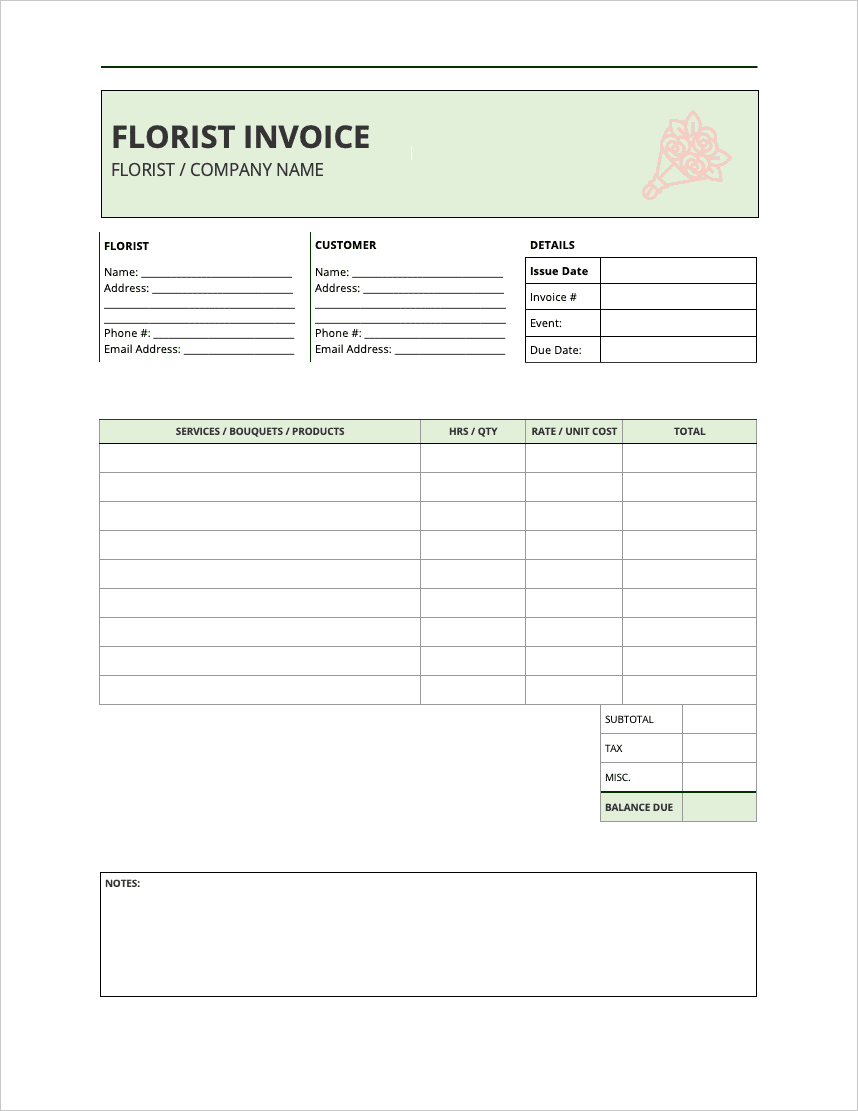Florist Invoice Template
A florist invoice is a single-page form given to customers after they’ve received custom bouquets, event setup, and other specialized services and/or products. The document specifies when the service (or products) were provided, what event it was for, how long the customer has to pay (if not upon receipt), the contact information of the florist, and any other notes they wish to include. Each service or product is listed in the table, along with the number of products (or hours dedicated to each service) and the cost per hour/product. The invoice can be customized to the needs of the florist, which is easiest after downloading the Word (.docx) format.
What is a Florist?
A florist is a person responsible for creating arrangements from flowers and foliage cuttings. Part artist, part horticulturist, a florist works behind the scenes to make special works of art for major life events.
Often called floral designers, florists must understand the life expectancy of cut flowers, which flowers work well with others, and how to increase the shelf life and beauty of each bloom. Although a florist might grow flowers, most often he or she would order flowers from greenhouses and wholesalers to use in her arrangements.
Florists can work in a variety of venues. A shop owner would also employ assistance florists to help, especially in the busy seasons around holidays such as Valentine’s Day or Christmas. Other florists work for clients in the hotel or entertainment industries.
How Florists Bill their Clients
Florists charge clients in one of two ways: either by the hour or by the event. In most cases, the florist will add a percentage (usually between 20-50%) of the wholesale price of the flowers in order to reach the total price. An invoice also includes setup and delivery fees for the florist to be on-site the day of the event, and these fees can total up to 15% of the total cost of the flowers.
There are two major ways that florists bill their clients. The first way is a recurring invoice. These invoices are for weekly or monthly jobs, such as flowers at the receptionist desk of a hotel or business. The invoice is emailed or sent at regular intervals, and clients choose the appropriate payment method. Recurring invoices are helpful because they offer a regular form of income that floral designers can count on.
The second type of invoice for florists is a special event invoice. As the name implies, these invoices are for weddings, funerals, or anniversary parties that occur one time. In addition to the cost of the flowers, the special event invoice includes the labor cost of creating the flower arrangements, as well as the setup and delivery fees.
Another way that florists can make money is through the rental of urns or table centerpieces. Often, clients are not interested in owning twenty (20) tables worth of vases, but by renting out urns or centerpieces or arches, you can gain even more revenue. These rental costs get added to the invoice, and for the one time purchase cost for the containers, a florist can continue to receive rental money.
